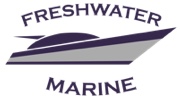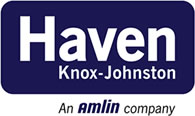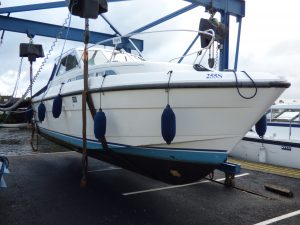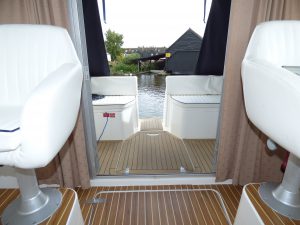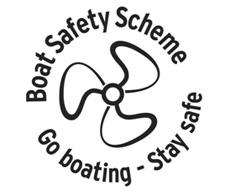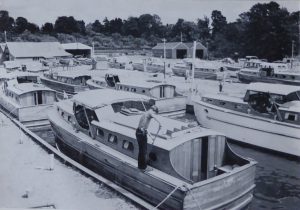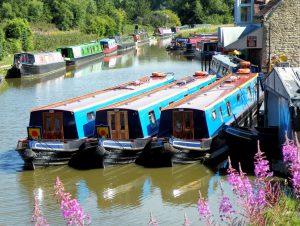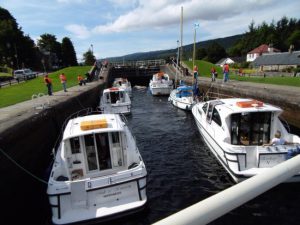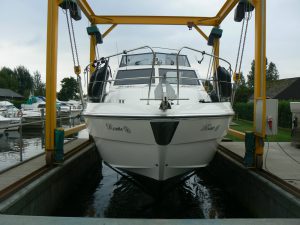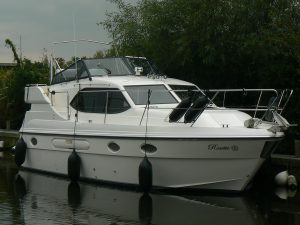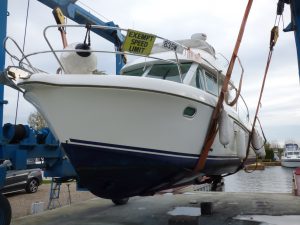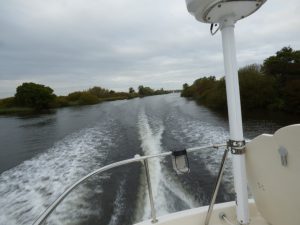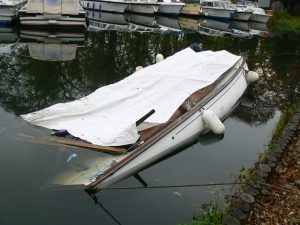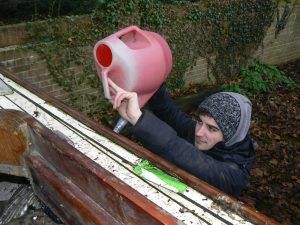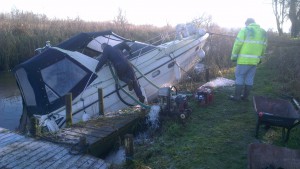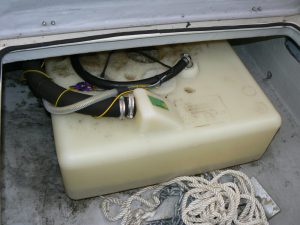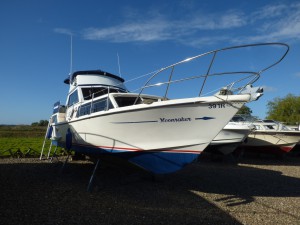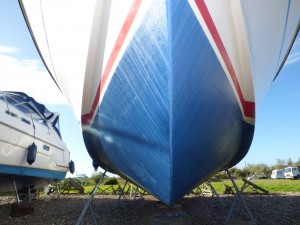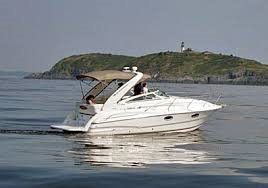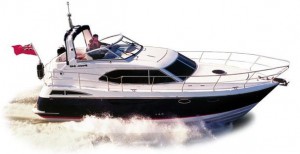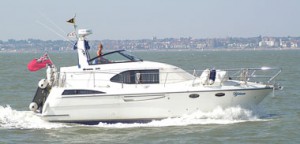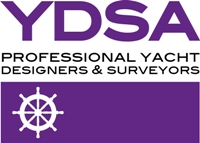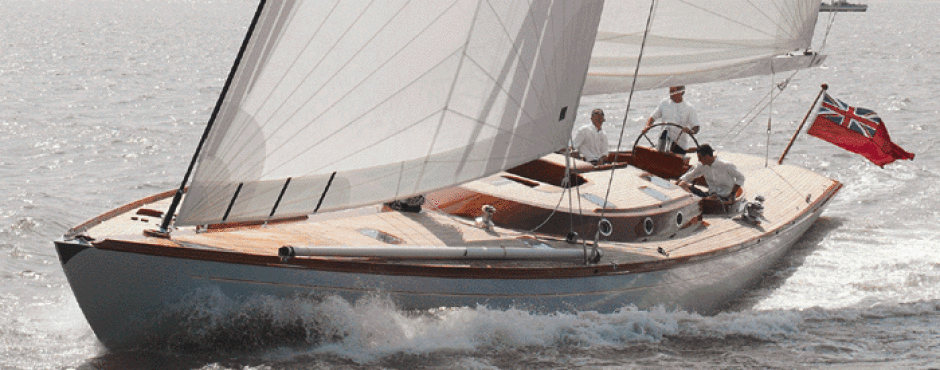
Broom 29HT | Pre Purchase Survey | # 01322October 1, 2017
Broom 29 HT In slings awaiting Pre Purchase Survey
European Marine Services recently carried out a Pre Purchase Inspection on this Boom 29HT c 1993 at Barnes Boatyard Wroxham being fitted with a single Nanni 50hp diesel engine on conventional drive propulsion
Her sedan styling is very popular on the inland waterways with easy stern access from the bathing platform, good deck space and very comfortable accommodation. Brooms have built several of these for their own hire fleet over the years and several made their way over to Ireland to be hired out on the River Shannon and other waterways
This boat was well built and despite her age and being currently moored in fresh water exhibited no signs of osmosis
The Accommodation
Inside, the accommodation is well presented. With an enclosed wheelhouse with two fixed helm seats then leading down to a open plan saloon to starboard with free standing table and galley to port – Plus a good sized WC / shower room and 2 berth accommodation to the bow.
The decks are reasonably wide for a vessel of this size which does not appear to affect the accommodation size inside. Raised inner deck pulpit rail give you that sense of security as you pass round the boat whilst she is under way.
This was a very well presented vessel which had been reasonably well maintained.
On this Broom 29HT the following items required attention:
Windows, Seacock Valves / Skin Fittings, Fuel System, Batteries Bilge & Pumping System, Fire Extinguishers, LPG System
For more information contact European Marine Services Ltd. Marine Surveyors & Consultants
EMS also undertake Boat Safety Inspections & Engine Inspections
Tel: 01603 327 123
Boat Safety Scheme – Hire Boats as from April 2017September 28, 2017
Over that past few years the Boat Safety Scheme Office in conjunction with the Hire Trade, BSS Examiners, Navigation Authorities and Hirer Representatives have been reviewing the existing Examination Checking Procedures (ECP’s) relating to UK Hire Boats. This year saw the implementation of the New 2017 (ECP’s) which took effect on the 1st April.
A revised set of requirements and modernised checking procedures are now applied to hire craft. Hire craft in this case are any powered boats such as weekly and day hire vessels:
- Let or hired under an arrangement, whether or not on a pre-contract basis;
- The subject of a bare boat charter arrangement;
- The subject of any form of third-party managed shared-use arrangement (including timeshare or shared ownership).
The term ‘hire boat’ does not include:
- Privately owned or managed boats;
- Boats operating commercially with a skipper or crew, and which carry passengers;
- Shared-ownership boats managed jointly by the private owners;
- Workboats;
- Emergency service boats and rescue boats.
- Hotel boats,
- Boats let as residences or longer term accommodation
From 1 April 2017:
1A) The BSS Examination Checking Procedures for Privately Owned and Managed Vessels will apply to all hire boats.
All relevant private boat BSS checks are mandatory compliance for hire boats, whereas for privately-owned and managed boats the set of checks is a mix of requirements and advice checks.
For the avoidance of doubt, these are the checks for Hire Boats that are required compliance and that also appear in the private boat examination procedures as advice checks.
| Check Item Reference | Check Question |
| X3.7.1R | Is the electrical system insulated from the hull? |
| X3.8.1R | Are all A.C. shore-power and battery charging lead inlet connections of the correct type in good condition, and suitably protected from the weather? |
| X3.8.2R | Are all shore-power, battery charging, and other A.C. power source lead connections of a suitable type? |
| X3.8.3R | Are all shore-power, battery charging, and other A.C. power source leads and connectors in good condition? |
| X3.9.1R | Is it impossible to connect simultaneously more than one power source to the alternating current distribution system? |
| X3.9.2R | Do all A.C. electrical circuits pass through a consumer unit? |
| X6.3.1R | Is the vessel provided with adequate means of escape? |
| X8.10.1R | Are all appliances requiring a flue, or exhaust fitted with one? |
| X8.10.1R | Are all appliances requiring a flue, or exhaust fitted with one? |
| X8.10.2R | Are all appliance flues and exhausts complete and in good condition? |
| X8.10.3R | Do all appliance flues and exhausts terminate directly to outside air? |
| X8.10.4R | Are all open flues to LPG appliances operating effectively? |
| X8.10.5R | Are all solid fuel appliances free of unintended gaps? |
| X8.9.1R | Is the vessel provided with adequate fixed ventilation? |
| X8.9.2R | Are warning notices displayed on sea-going boats with closable ventilators? |
To view and download the public edition the BSS Examination Checking Procedures for Privately Owned and Managed Vessels BSS (version 3.0 April 2015) click here.
1 B) New and revised BSS checks also apply to hire boats in addition to the private boat ones mentioned above. These additional BSS Requirements for hire boats are made up of seven new checks and nine original requirements from Part 10 of the 2002 BSS Standards.
To view and download the list of additional BSS Requirements for hire boats click here.
Technical support for any hire boat operator seeking information to help move their fleet to full compliance is available by using the ‘contact-us‘ page on this site where questions, photos, diagrams and supporting documents can be uploaded to the BSS website or call 0333 202 1000.
Background information from the hirer safety review and resulting consultation leading to the new BSS Hire Boat Requirements for April 2017
The original September 2015 consultation paper (now closed) and details of the revisions – click here
A short summary of the changes proposed arising out of the consultation (Sept 2015) can be read here. (Feb 2016)
A summary of the impact for hire operators as a result of the adoption of the private boat checks for hire boats, click here as published for the 2015 consultation
A hard copy of the 2015 consultation document is available upon request.
All comments and the BSS responses in detail can be viewed here (Feb 2016).
The news release (Feb 16) announcing decision to implement the revised BSS hire boat requirements from April 2017 can be viewed here
For more information contact European Marine Services Ltd. Marine Surveyors & Consultants
EMS also undertake BSS Inspections & Engine Oil Analysis Reports
Tel: 01603 327 123 www.europeanmarinesurveys.com
Norman 18 | Accidental Sinking ‘Out of Sight Out of Mind’ | # 01282September 14, 2017
European Marine Services Ltd inc. European Marine Surveys carry out insurance Damage Assessments and Loss Adjusting etc for most of the major Marine Insurance Companies – plus Marine Surveys for Insurance Purposes
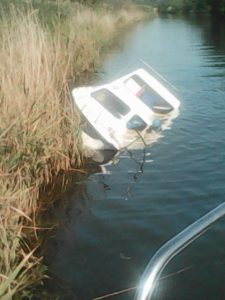 Norman 18 – Accidental Sinking
Norman 18 – Accidental Sinking
REMEMBER to check and service those fittings below the floors which are not obvious being ………….
‘Out of Sight – Out of Mind’
This was a very unfortunate accident and was consequent of a ‘loose’ skin fitting’ in the bottom of the boat – feeding cooling water to the engine
In summary the raw water seacock involved fed the engine cooling and was therefore subject to some vibration. It would appear that over time the vibration resulted in the securing nuts etc working loose thus allowing limited ingress of water
Regretfully there was no 12v Auto bilge pump – Which is an Insurance Requirement
The Norman 18 was left overnight moored in some reeds due to engine failure and upon the return of the owner the next day he found the above – see photo
This boat was the owner’s treasured possession and though the vessel was old, the owner nevertheless got a lot of pleasure just river cruising and watching the world pass by………..
History – Norman Cruisers of Shaw, Lancashire were a prolific designer of inland cruisers, building a total of 7000 craft. The company founded in the late 1950s went into GRP production in the mid 1960s, starting with the Norman 17.
The business ceased trading in December 1979 (The Winter of Discontent) and started again in 1980. New models were introduced 24, 27 and 22 wide beam but the moulding shop was destroyed in a fire in 1982. This destroyed most of the moulds and the business never recovered. Some moulds were re-built and when the business finally ceased, these were sold and marketed under other names. Also some designs were copied and made into hybrids.
In the 1970s around 65% of boats were exported. Principle markets (in order of Volume) were Holland, Germany, Norway, France, Sweden. Boats in Holland were imported by Internaut of Rotterdam and were sold under the name of “Inter”. Hence the 20 was the Inter620.
Norman Cruisers were in the top 3 largest pleasureboat builders in the UK. Westerley Yachts being the biggest.
For more information contact European Marine Services Ltd. Marine Surveyors & Consultants
EMS also undertake BSS Inspections & Engine Oil Analysis Reports
Tel: 01603 327 123 www.europeanmarinesurveys.com
Rosebank 34 | Twin Diesel Motor Cruiser | # 01299September 13, 2017
Rosebank 34 Built Co Leitrim, Ireland
We recently carried out a Pre Purchase Inspection on a Rosebank 34 c 1999 fitted with twin Volvo Penta diesel engines – being a model of motorboat that we do not come across very often and built by Rosebank Marine in Carrick on Shannon, Co Leitrim, Ireland
Her styling is very much the same of many boats today (ie Broom Boats, Haines etc) with a nice aft stateroom, upper steering position and outside seating
This boat was extremely well built and despite her age and being currently moored in fresh water exhibited no signs of osmosis
The Accommodation
Inside, the accommodation is well presented. An open plan forward saloon with circular table & galley alongside. Plus a main saloon wit L shaped settee which makes into a double bed – Plus a good sized WC / shower room and 2 berth accommodation to the bow.
The decks are reasonably wide for a vessel of this size which does not appear to affect the accommodation size inside. Stanchions and hand rails give you that sense of security as you pass round the boat whilst she is under way.
All told, this was a very well presented vessel which had been well maintained.
On this Rosebank 34 the following items required attention:
Fuel System Fire Safety
Stern Packing Glands
We found there to be moisture staining to tops of furniture and to some hard linings
For more information contact European Marine Services Ltd. Marine Surveyors & Consultants
EMS also undertake Boat Safety Inspections & Engine Inspections
Tel: 01603 327 123 www.europeanmarinesurveys.com
Jeanneau Merry Fisher 925 | Pre Purchase Survey & River Trials | # 01158
- Length overall: 32ft 1in (9.78m)
- Beam overall: 10ft 4in (3.16m)
- Draft: 2ft 9in (0.85m)
- Weight: 4.96 tons (4500kg)
The Jeanneau Merry Fisher 925, built in c 2008 underwent a pre purpose survey and river trial. Jeanneau (Europe’s largest builder) produce an extensive range of sports cruisers for the inshore and offshore market. This Merry Fisher 925 has a pair of Yanmar 260hp inboard diesel engines on conventional drives. She benefits from having two helm positions, both of which have good visibility around the boat as you manoeuvre.
The Jeanneau Merry Fisher 925 is an express cruiser that owners typically ordered in the optional flybridge version. The boat doubles as a cruiser for family and friends or a practical sportsfisher. It offers the most spacious and roomy interior of any boat in its class. The large cockpit has teak flooring, an aft bench seat and a transom door to a bathing or fishing platform. There is ample accommodation with five berths in two cabins plus a saloon. The Jeanneau Merry Fisher 925 offers a versatile, reliable choice in the second-hand market.
River Trial
Out on the water she handled very well, both engines pulling strong all the way up to around 3600 rpm, giving her a top speed of approximately 22 mph. Noise from the engines is kept to a minimum with a good layer of sound proofing within the engine space and minimal exhaust note from the transom. At low speed she also handled well, turning on a sixpence in those tight spots. This vessel also benefits from having a bow thruster.
- A beautiful, speedy and reassuringly stable recreational boat, combining a spacious and comfortable interior with considerable self-sufficiency over long distances.
- Awarded the ‘Highly Commended’ accolade in Motor Boats Monthly after its initial launch. Low fuel consumption, good seaworthiness and good protection inside.
- Smooth and quiet. Engine noise is pretty nice, like a good car
- Very good visibility and comfort for long trips.
The Accommodation
Inside, the accommodation is well presented. An open plan saloon / galley meets you when you first enter the vessel, moving forward there is a reasonable sized WC / shower room and 2 berth accommodation to the bow. The decks are reasonably wide for a vessel of this size which does not appear to affect the accommodation size inside. Stanchions and hand rails give you that sense of security as you pass round the boat whilst she is under way. All told, this was a very well presented vessel which had been well maintained.
On this Jeanneau Merry Fisher 925 the following items required attention:
- Fire Extinguishers Serviced
- Auto Bilge Pump Operation
- Carbon Monoxide Alarm Installed
- LPG System tested for soundness
For more information contact European Marine Services Ltd. Marine Surveyors & Consultants
EMS also undertake Boat Safety Inspections
Tel: 01603 327 123 www.europeanmarinesurveys.com
Herbert Woods GRP Sailing Yacht | How Did This Yacht Sink ? | # 01172February 11, 2017
Background
European Marine Services undertake insurance claims, disputes and investigations for most of the UK’s leading insurance companies and this Herbert Woods GRP yacht was subject to an accident damage inspection in early 2016 involving a damaged keel – We duly inspected, estimated costs, reported, approved repairs and both ourselves and the insurance co thought that was an end to the matter.
Many months later following some quite expensive repairs the yacht heads south to the southern rivers for winter storage. The owner leaves the boat tied to the quay heading overnight – In the morning the yacht is found as seen above – SUNK
All initial suspicions fall on the earlier repairs (which had also involved sinking) and of course the repairers yard which needed to be eliminated
The first problem was how to get this yacht out of the water which duly involved large strops (plus a diver) and secured land ties to haul the yacht upright followed by a pumping operation – Expensive
Investigation
The first question to be answered was had the earlier keel repair(s) contributed to the sinking – No
The second question was to establish if any of the many underwater skin fittings / seacock valves had failed, and though several of the installations were very much a DIY installation it would appear they all were ‘sound’
Engine propeller shaft, stern tube gland, rudder tube and all associated fittings when inspected appeared secure
Water was also seen to be ‘dripping’ from the aft end of the keel moulding (laminations) but not in enough volume / quantity to result in such a quick sinking
This presented a problem as this yacht did not sink without ‘due cause’ and there were no other through-the-hull-fittings and no damage
OR were there ?? Well Yes …………………..
Sited below the aft portside gunwale was the exhaust outlet to a hot air heater – and all appeared secure, and other than a visual inspection there was no way of checking
There had to be a reason for the sinking and the resourceful boat yard owner suggested we pour water from a watering can through the exhaust hull outlet
Pouring water into exhaust outlet / resourceful boat yard owner
Lo and behold the water poured through the exhaust piping entered the hot air heater and exited through the air manifold into the boat AND in addition the exhaust hose was split at the unit junction and again water was viewed entering the boat
Summary
The sinking was consequent of the following:
The yacht’s keel at low tide sat on the river bottom and the yacht leaned outward due to slack mooring ropes
As the tide turned the water came firstly up the hull’s port side before there was enough buoyancy for flotation
Water entered the hot air heater exhaust outlet and into the heater unit and out through the air inlet. In addition through the faulty / split exhaust hosing
With the yacht leaning well over to port – As the tide rose the cockpit slowly filled with water through the exhaust hosing with the inevitable conclusion that there was never enough buoyancy to float this yacht. Eventually the tide was above the port cockpit coaming and that was the end.
For more information contact European Marine Services Ltd. Marine Surveyors & Consultants
EMS also undertake Boat Safety Inspections
Tel : 01603 327 123 www.europeanmarinesurveys.com
Winters’ here – Problems with Water in Fuel TanksNovember 22, 2016
Water gets in to fuel tanks in many different ways, through access ports and filler caps with faulty/damaged seals, tank vent breathers and from external sources such as re-fuelling bulk tanks and containers and Such as above – bad parking
Boat owners do not use their boats in the same way as they use their cars. Many boats are laid up for long periods particularly through the winter months. One of the main causes of fuel related issues is water contamination.
Water contamination is the starting point for bacterial growth, commonly known as ‘diesel bug’ and once in the system it can take some extensive and sometimes expensive work to get rid of it.
Of all the users of diesel fuel the operators of boats are the most likely to encounter problems with water contamination, fungus and bacteria for the following reasons:-
- Boats operate in a wet environment and it is not always possible to stop water seeping into fuel tanks.
- The fuel tanks on boats are designed to fit into restricted or unusually shaped areas to make the best possible use of available space. This can mean that they can be difficult to drain and often have areas where free water can collect and sit undisturbed.
- The fuel tanks contain baffles to stop the fuel sloshing about. The baffles can trap free water in small pockets.
- In warmer climates boats operate in areas with high humidity. Water in the air enters the boat tanks through the breather and condenses inside the tanks.
Where free water is present it will provide a site for fungus and bacteria to grow. Often the fungus or bacteria will develop for a long time without causing any problems until one day they become disturbed and stirred up into the fuel. This will be noticed when filters start blocking with a black slime which is the dead matter from the fungus and bacteria. The fungus can be stirred up by:-
- Vigorous movement due to re-fuelling, waves, rough sea or a storm, etc.
- The fungus population reaches a size at which it grows and spreads into the rest of the fuel.
- The natural life cycle of the fungus reaches a point at which dieback occurs and dead matter floats in the fuel.
- The fungal activity reaches a point at which natural surfactants produced by the fungus cause water and dirt to be suspended in the fuel and the fuel becomes hazy.
PREVENTION:
On land the normal prevention of fungal problems is to regularly drain any water in which the fungus can grow. This may not be possible in most boats because the fuel tank shape does not provide a common draining point for all water pockets. An effective method of removing free water and preventing any build-up of water is to insert an Aqua-Zorb cell in to the tank. These cells will absorb the water and are easily inserted through the filler cap and removed the same way. Aqua-Zorb cells are available in a large range of sizes and are suitable for small tanks and for all sizes of bulk storage tanks.
To prevent water getting in through the tank breather then consider fitting a Des-Case Desiccant Breather, these absorb moisture from the air as it is drawn in to the tank and also absorb moisture when air is expelled from the tank.
Consider regular treatment with a biocide or fuel treatment. The biocide should be one that can be added to the fuel that kills the fungus and stops it growing in the water. An example of effective biocides is Marine 16.
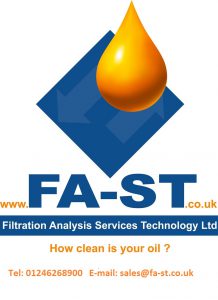 All products are available from FA-ST Filtration Analysis Services Technology Ltd Tel: 01246268900 or e-mail [email protected] or visit www.fa-st.co.uk for more details or buy on line at www.oilsampling.co.uk
All products are available from FA-ST Filtration Analysis Services Technology Ltd Tel: 01246268900 or e-mail [email protected] or visit www.fa-st.co.uk for more details or buy on line at www.oilsampling.co.uk
FA-ST Ltd is actively looking for more distributors throughout the UK, Europe & Worldwide for their products and services.
For more information contact European Marine Services Ltd. Marine Surveyors & Consultants
EMS also undertake Boat Safety Inspections
Tel : 01603 327 123 www.europeanmarinesurveys.com
Moonraker 350 | Pre Purchase Survey | # 01146November 20, 2016
We have not inspected a Moonraker since about 2010, then as the saying goes along come three Moonraker Pre Purchase Inspections in the same year.
This Moonraker was being sold by Anglia Yacht Brokers of St Olaves and was available for inspection out of the water. For those of you who need an inspection (or service) their 50 tonnes gantry / travel lift is most efficient and reasonably priced
The Moonraker inspected was built in 1975 and fitted with 2x Perkins HT 6.354 @ 175hp ea. diesel engines. These engines being the inclined model which from a surveyors perspective makes engine room inspection very difficult as there is very limited space to actually gain access.
Moonraker Models
As well as the 3 main types of Moonraker available (Sedan, Cruiser and Sports Yacht, with many variations of these also available) from 1972, coloured hulls were also available, the first being yellow. The ‘D’ series was introduced in 1973, which extended the forward cabin windows so giving greater head/standing room
The Moonraker 350 was a forerunner with the hull design being considered a medium V being very sea-kindly and relatively dry and a picture of the underwater sections is shown below
The boat we inspected was considered acceptable in structure but like all well reasonably maintained 40 year old craft had a few problems
There was evidence in underwater areas from the sample / random areas inspected of osmotic blistering ranging up to 25mm dia. Viewed over most of the entire hull being expected – However no boat has sunk consequent of general osmotic blistering and osmotic blistering today is no longer the show stopper is used to be
We also undertook engine oil analysis (samples) of both engines the result showing that one engine had a higher degree of wear, which when re-sampled having changed the oil and run for a while returned to acceptable readings. A fairly high number of oil analysis samples that we take give ‘false’ readings consequent of a lack of oil changes over several years allowing the build up of unwelcome deposits
For Information on Oil Sample Analysis please visit our website link:
For those of you whom are interested, and to give some idea as to the background of Moonraker Marine / JCL / Colin Chapman & Lotus Cars we have reproduced the history from www.moonrakerboats.com and acknowledge them accordingly ………..
Please visit our earlier Blog # 01011-16
For more information contact European Marine Services Ltd. Marine Surveyors & Consultants
EMS also undertake Boat Safety Inspections
Tel : 01603 327 123 www.europeanmarinesurveys.com
Carbon Monoxide on Boats KillsNovember 15, 2016
Each year boaters die or are made seriously ill from carbon monoxide (CO) poisoning. Boats are built to keep water out, but this also makes them good containers for gases and fumes.
We at European Marine Services are constantly promoting & recommending in our Pre Purchase Surveys the installation / fitting of Carbon Monoxide Detectors on all boats with internal propulsion engines
Carbon monoxide is a poisonous gas that has no smell or taste. Breathing it in can make you unwell, and it can kill if you’re exposed to high levels.
Every year in the UK, more than 200 people go to hospital with suspected carbon monoxide poisoning, which leads to around 50 deaths.
After carbon monoxide is breathed in, it enters your bloodstream and mixes with haemoglobin (the part of red blood cells that carry oxygen around your body), to form carboxyhaemoglobin.
When this happens, the blood is no longer able to carry oxygen, and this lack of oxygen causes the body’s cells and tissue to fail and die.
The longer you inhale the gas, the worse your symptoms will be. You may lose balance, vision and memory and, eventually, you may lose consciousness. This can happen within two hours if there’s a lot of carbon monoxide in the air.
The Norfolk Broads
2016 has been a bad year for CO accidents with the two deaths on Wroxham Broad earlier in the summer. Which if a carbon monoxide detector had been installed – this fatal accident may well have been prevented.
NB: This accident was NOT the result of an installed LPG system, but consequent of engine exhaust fumes
Only this month we had another example of exhaust fumes (carbon monoxide) being released by the engine / exhaust hose installation within the living / accommodation space, which release was detected thankfully by a newly installed detector – Nobody was harmed
It is important to note that CO detectors are NOT currently part of the Boat Safety Scheme – Install CO alarm certified to BS EN 50291-2
CO build-up in the cabin can occur with one or a mix of these factors:
- with faulty, badly maintained, or misused appliances
- exhaust fumes from a boat’s engine or generator PLUS perished / faulty / blocked exhaust hosing
- escaped flue gases from solid fuel stoves
- blocked ventilation or short supply of air – fuels need the right amount of oxygen to burn safely
For more information contact European Marine Services Ltd. Marine Surveyors & Consultants
EMS also undertake Boat Safety Inspections
Tel : 01603 327 123 www.europeanmarinesurveys.com
Broom 345 – Pre Purchase Survey & River Trial # 01131September 27, 2016
With boat sales pre purchase surveys & insurance surveys keeping us very busy this summer, it was a joy to finally get out on the water on this Broom 345 river trial to see how she performed & handled.
Due to distances and time required to reach open water we undertook river trials making use of the derestricted zone where we were able to maximise performances etc Our standard trials programme is to undertake speed trials at varying engine RPM both with and against current, emergency stops from max speed passing through neutral to reverse, turning performance to include figure of eight at both low and high speed. Photographing and recording speeds with GPS with associated engine instrumentation readings and much more besides
For more information on Static / Sea / River Trials visit:
https://www.europeanmarinesurveys.com/marine-surveys/static-sea-river-trials-report/
This 1997 GRP express motor cruiser is fitted with a pair of Yanmar 6 cylinder 315 hp inboard diesel engines.
Typical of the Broom aft cabin design, this 345 has a full beam master cabin in the stern, featuring separate en suite shower room & WC. A light and airy saloon with a V berth in the forward cabin, galley and forward WC at the front.
On river trials she behaved very well, cruising up to a comfortable 30mph (GPS). Very stable whilst getting on the plane with responsive steering & the Yanmar engines pulled very well all the way up to 3600+ rpm.
As expected there was nothing negative to report from the river trials
As usual in any second hand boat however well maintained there were a few mainly minor items to report to include such lack of labelling, access to fuel systems, servicing of seacock valves, auto bilge pump operation, we always recommend a carbon monoxide alarm and of course as expected no osmosis was found – with low hull / GRP moisture meter readings
This example was well presented, in good order throughout and a joy to survey. We wish the purchaser all the best for the future.
For more information contact European Marine Services Ltd. Marine Surveyors & Consultants
Tel : 01603 327 123 www.europeanmarinesurveys.com



